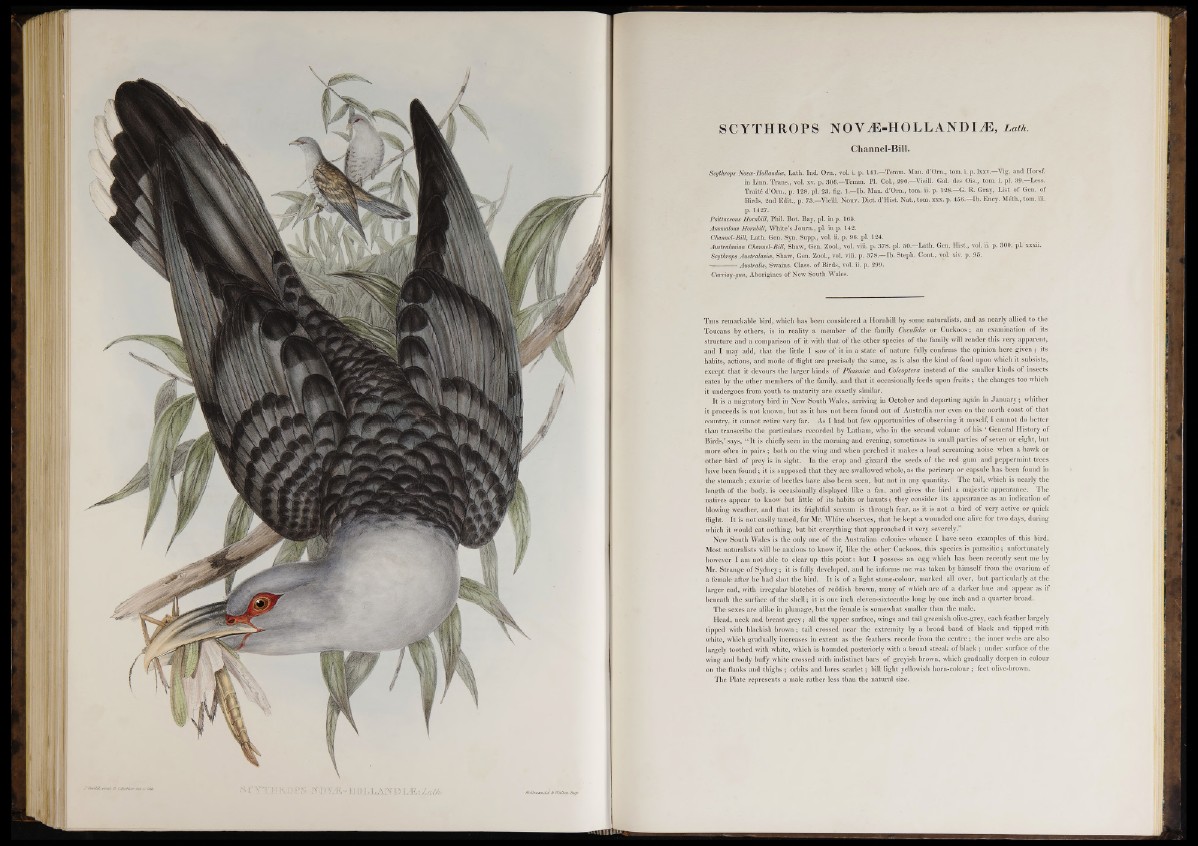
SCYTHROPS NOVÆ-HOLLANDIÆ, W M
Channel-Bill.
Scythrops Novce-Hollandia, Lath. Ind. Om., vol. i. p. 141.—Temm. Man. d’Orn., torn. i. p. lxxv. Vig. and Horsf.
in T.imv Trans., vol. xv. p. 306.—Temm. Pl. Col., 290—YieiiL Gal. des Ois., tom. i. pl. 39 —Less.
Traité d’Om., p. 128. pl. 23. fig. 1—Ib. Man. d’Om., tom. ii. p. 128.—G. R. Gray, List of Gen. of
Birds, 2nd Edit., p. 73.—Yieill. Nouv. Diet. d’Hist. Nat., tom. xxx. p. 456.—Ib. Ency. Métb., tom. iii.
p. 1427.
Psittaceous Hombill, Phil. Bot. Bay, pl. in p. 165.
Anomalous Hombill, White’s Joura., pl. in p. 142.
Channel-Bill, Lath. Gen. Syn. Supp., vol. ii. p. 96. pl. 124.
Australasian Channel-Bill, Shaw, Gen. Zool., vol. viii. p. 378. pl. 50.—Lath. Gen. Hist., vol. ii. p. 300. pl. xxxii.
Scythrops Australasia, Shaw, Gen. Zool., vol. viii. p. 378.—Ib. Steph. Cont., vol. xiv. p. 95.
— — Australis, Swains. Class, of Birds, vol. ii. p. 299.
Curriay-yun, Aborigines of New South Wales.
T h is remarkable bird, which has been considered a Hombill by some naturalists, and as nearly allied to the
Toucans by others, is in reality a member of the family Cucúlidas or Cuckoos; an examination of its
structure and a comparison of it with that of the other species of the family will render this véry apparent,
and I may add, that the little I saw o f it in a state o f nature fully confirms the opinion here given ; its
habits, actions, and mode o f flight are precisely the same, as is also the kind o f food upon which it subsists,
except that it devours the larger kinds o f Phasmias and Coleóptera instead of the smaller kinds of insects
eaten by the other members o f the family, and that it occasionally feeds upon fruits ; the changes too which
it undergoes from youth to maturity are exactly similar.
It is a migratory bird in New South Wales, arriving in October and departing again in January; whither
it proceeds is not known, but as it has not been found out of Australia nor even on the north coast o f that
country, it cannot retire very far. As I had but few opportunities of observing it myself, I cannot do better
than transcribe the particulars recorded by Latham, who in the second volume of his ‘ General History of
Birds,’ says, “ It is chiefly seen in the moruingand evening, sometimes in small parties o f seven or eight, but
more often in pairs ; both on the wing and when- perched it makes a loud screaming noise when a hawk ór
other bird o f prey is in sight. In the crop and gizzard the seeds of the red gum and peppermint trees
have been found; it is supposed that they are swallowed whole, as the pericarp or capsule has been found in
the stomach ; exuviae of beetles have also been seen, but not in any quantity. The tail, which is nearly the
length of the body, is occasionally displayed like a fan, and gives the bird a majestic appearance. The
natives appear to know but little o f its habits or haunts; they consider its appearance as an indication of
blowing weather, and that its frightful scream is through fear, as it is not a bird of very active or quick
flight. It is not easily tamed, for Mr. White observes, that he kept a wounded one alive for two days, during
which it would eat nothing, but bit everything that approached it very severely.”
New South Wales is the only one of the Australian colonies whence I have seen examples o f this bird.
Most naturalists will be anxious to know if, like the other Cuckoos, this species is parasitic; unfortunately
however I am not able to clear up this point: but I possess an egg which has been recently sent me by
Mr. Strange o f Sydney; it is fully developed, and he informs me was taken by himself from the ovarium of
a female after he had shot the bird. It is o f a light stone-colour, marked all over, but particularly at the
larger end, with irregular blotches of reddish brown, many of which are of a darker hue and appear as if
beneath the surface of the shell; it is one inch eleven-sixteenths long by one inch and a quarter broad.
The sexes are alike in plumage, but the female is somewhat smaller than the male.
Head, neck and breast grey; all the upper surface, wings and tail greenish olive-grey, each feather largely
tipped with blackish brown ; tail crossed near the extremity by a broad band of black and tipped with
white, which gradually increases in extent as the feathers recede from the centre; the inner webs are also
largely toothed with white, which is bounded posteriorly with a broad streak of black ; under surface of the
wing and body buffy white crossed with indistinct bars of greyish brown, which gradually deepen in colour
on the flanks and thighs ; orbits and lores scarlet; bill light yellowish horn-colour ; feet olive-brown.
The Plate represents a male rather less than the natural size.